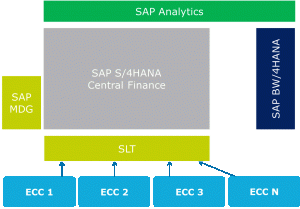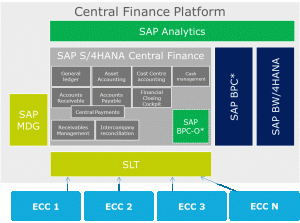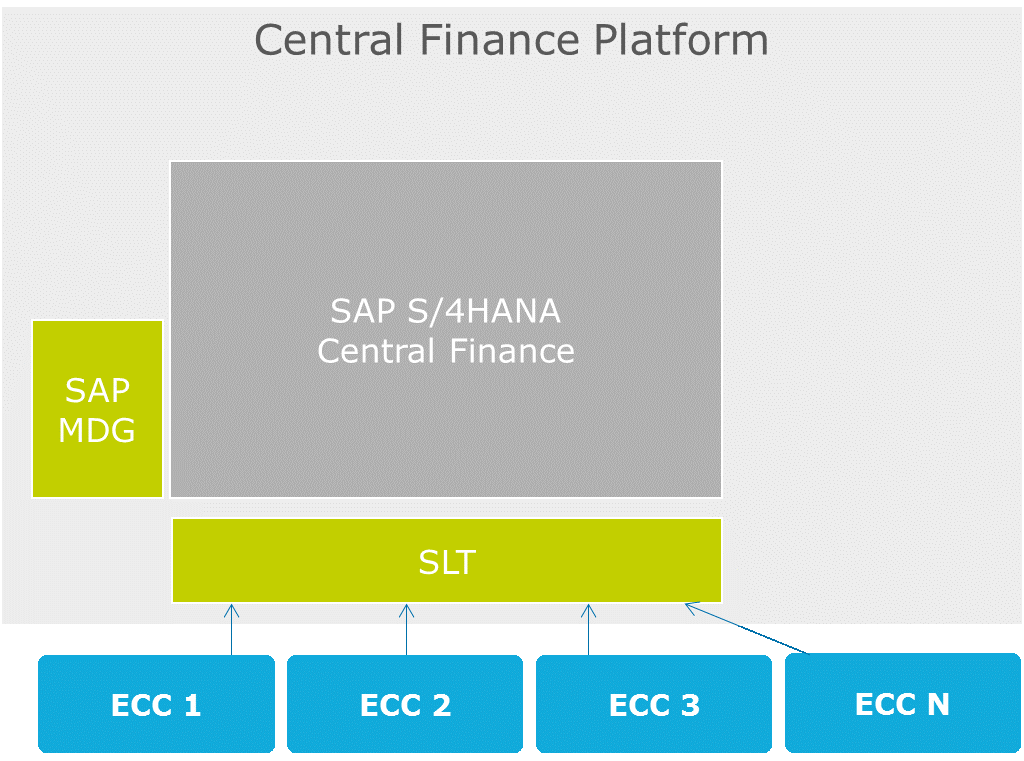SAP Central Finance, part 3: Central Finance as a platform for finance transformation
Blog: Capgemini CTO Blog
The previous blogs in this series have covered an overview of Central Finance (part 1) and our learning from implementation experience (part 2).
A platform for finance transformation
Central Finance in its simplest definition is the replication of finance transactions from source ERP to the Central Finance S/4HANA system, the transactions physically reposted in ACDOCA (the Universal Journal database table in S/4HANA). The diagram below shows this framework; for more detailed explanation please read part 1 here.

Figure 1: the basic CFIN platform with data replication only (note: source systems shown as SAP ECC, but this could also be S/4HANA or non-SAP systems).
This delivers a single repository of financial data from the disparate ERPs; however, this could easily be achieved by a data warehouse such as SAP BW or BW/4HANA. The key advantage with Central Finance is that it can provide reporting predicated on the replicated financial data based on actuals. What about more sophisticated financial reporting? What about financial planning? What about regional and group consolidation? And what about central finance operations?
As these questions are addressed, we will see how Central Finance moves position: from replication of transactions in S/4HANA to a platform for finance transformation.
There is not necessarily a right or wrong order to the topics that follow. But they are all important, depending on how you plan to evolve Central Finance.
A new organisation structure and data model as the basis for reporting and analytics and the future S/4HANA rollout
The right model
It is important to get the target Central Finance organisation structure and data model right; it must serve the needs of finance in the immediate terms but could also be the basis for a future S/4HANA template harmonisation (depending on the overall roadmap).
This should not be underestimated; multiple regions, capabilities and areas of the finance operating model will need to be engaged and aligned, as a business-led activity.
The reporting strategy
Organisational complexity, and the use of multiple source ERP systems, often means multiple corresponding SAP BW systems and/or other enterprise data warehouses. The availability of finance data in the Central Finance system naturally raises questions on the use and longevity of these systems.
A key question to understand is “can all financial reporting be delivered from the S/4HANA target system?”
- If the answer is yes then the use of legacy BWs for finance can start to reduce with reporting transitioning to Central Finance.
- If the answer (as is more likely) is no, then SAP BW (on HANA or S4/HANA) should be considered as a component part of the CFIN platform – see below.

Figure 2: Central Finance platform with SAP BW
This may not immediately create opportunities to decommission SAP BW systems; most likely the BW systems support wider reporting requirements than purely finance.
There is an opportunity, however, to start to move the delivery of all finance reporting to the Central Finance platform. This would require a detailed understanding of all data sources to deliver the complete suite of financial reports; this may require CFIN and the existing legacy ECC systems to provide the complete picture for financial information, e.g. sales information, material ledger, product costing etc.
A new BW system will require history and harmonisation of potentially different models in CFIN and legacy ECC systems does provide a complication that needs to be understood and managed.
What needs to change to deliver the target? Do I need to undertake remediation to source ECC?
There may be a need to consider this. Source ECC systems will need some technical update through the application of OSS notes to ready them for CFIN. However, changes may be required to business processes and system configuration in the source systems themselves to fulfil the requirements of the new target data model.
There is often divergence in source ECC system components and usage: New GL and non-New GL; document splitting and without; Profit Centre accounting active and not; divergence in COPA set up, lack of harmonised master data etc.
The extent to which you can ‘map your way out of’ the system divergence problem needs close attention and there may be some changes required to source ECC system set up and process governance to drive more consistency from source.
This in turn should be seen as a positive driver towards harmonisation of processes and one step closer to adopting S/4 HANA.
Financial planning and forecasting also needs to be considered
Local processes and tooling will most likely exist. They may be predicated on the aforementioned local BWs (could include SAP BPS, SAP BPC, spreadsheets etc).
Implementing a harmonised process and tooling requires thought. Moving to harmonised processes is again a business change-led exercise to align regions/functions/stakeholders in finance.
But there is also whether financial planning could be executed in BPC optimised for S/4HANA (using embedded BW in the CFIN S/4HANA system) or whether the requirements are more complex and actually require non-financial data sets such as sales information, which are in the source ECC systems but not replicated to Central Finance.
In which case a more ‘standalone’ planning solution may be required. This could be a standalone SAP BPC solution (BPC version 11 on BW/4HANA or version 10.1 (on BW or BW for HANA)). SAP is also positioning SAP Analytics Cloud as a ‘first option’ for planning, which may become a viable option as the product matures. And the optimised BPC for S/4HANA for planning, in our experience, needs careful thought unless the requirement is pure cost centre (or internal order) type planning.

Figure 3: Central Finance platform with planning and BW
Group consolidation options
There may be existing local tooling to complete regional consolidation prior to group consolidation. There may be non-SAP solutions for consolidation, e.g. HFM, TM1. However, although it may not be in the first release of the Central Finance platform, consolidation is an obvious candidate for BPC optimised for S/4HANA, that is BPC embedded in the Central Finance S/4HANA system itself, without the need for a standalone solution. SAP has also released S/4HANA Group Reporting, a Cloud product, that provides consolidation functionality (as well as other ‘last mile’ finance operations, such as disclosure), and which should also be considered for the target architecture.
Transitioning Finance operations
The first step in the CFIN platform journey might be delivering the single source of truth for finance for reporting. This might include first steps for planning and consolidation processes.
The next step could be to transition certain finance operations to Central Finance S/4HANA. This could include payments (using Central Payments functionality), receivables management (collections, dispute handling etc), capex processing, indirect procurement etc.

Figure 4: Central Finance with finance operations
The longer-term roadmap
As we’ve discussed in previous blogs, SAP Central Finance is an SAP S/4HANA system. It creates opportunity for faster deployment of S/4HANA for centralised, consolidated financial reporting but can also deliver centralised finance operations (centralised payments, intercompany reconciliation, financial closing etc).
Then what? How do you move to a single instance of SAP and transition logistics and other upstream processes into the S/4HANA Central Finance instance? Is there the appetite to do this? Is it even possible?
The following is not exhaustive but provides some options to consider.
Option 1 – lift and shift by e2e process
If supply chain transactions and intercompany processing are not particularly complex then it might be possible to lift and shift e2e value chains (by geography, region, perhaps company code) into the target system.
Under this option, an e2e process such as P2P or O2C, could be lifted from the source ERP and deployed into the target S/4HANA system. The target, harmonised template could be designed at the outset of the project or developed as you go.
Admittedly this would require simple sales or purchasing processes and may only work for indirect procurement but it is an option to consider if the e2e processes are discreet and not highly integrated (e.g. not back to back processing or intercompany SO/PO).
This may also drive temporary interfacing or manual workarounds into e2e integrated scenarios. Reporting needs to be closely considered to determine the impact.
Option 2 – System by system.
Requires larger scale template design and harmonisation at the outset to make sure that the template is holistic, or at least future-proofed. This is wider than a solely finance transformation and is a large-scale undertaking.
Option 3 – CFIN as part of the end-state
It may not be possible, or desirable, for organisations to achieve harmonisation to a single template. It could be too disruptive to business operations, too costly and time consuming, and difficult to create a compelling business case.
It might only be realistic for organisations to harmonise and decommission source ERPs to a certain degree, or to retain all source ERPs in the target Central Finance platform architecture. In both scenarios, finance operations can start to transition to Central Finance, with processes redesigned and shared services operations optimised.
SAP published a useful blog on this topic, which can be found here.
Conclusion
SAP Central Finance started life as a mechanism to deliver consolidated financial reporting; it also provided opportunity for starting the journey of an S/4HANA-enabled transformation with a “finance first” approach.
It has developed into more than that. Additional functionality provides opportunity for centralised finance operations in payments, cash collection and application, and month end processing. Future improvements proposed by SAP are in the areas of additional central processes and reporting, providing a data hub for real time consolidation, Central closing etc.
But to really drive finance transformation then think of Central Finance as a platform. A platform that incorporates analytics, planning, consolidation and finance operations.
Speak to our finance transformation experts to continue the discussion.
Leave a Comment
You must be logged in to post a comment.








